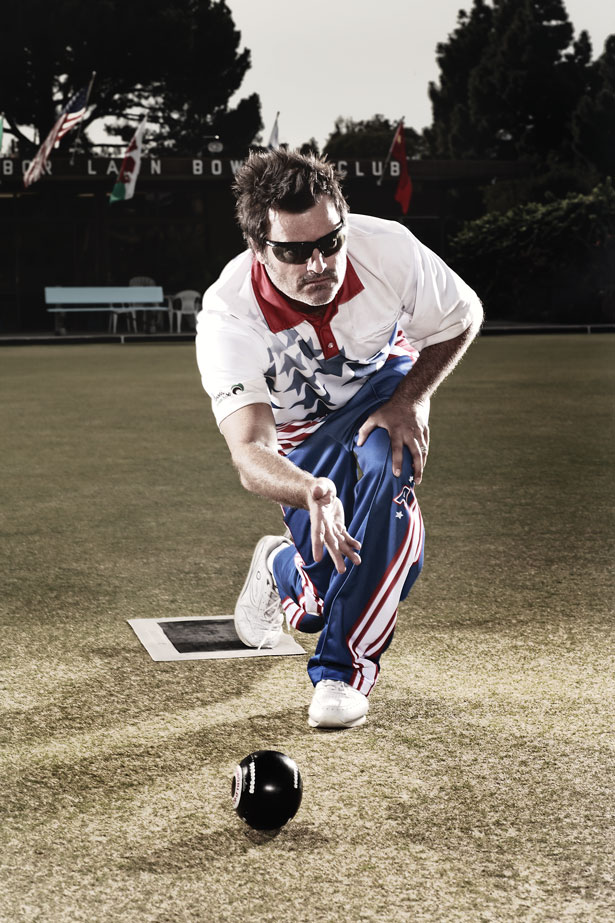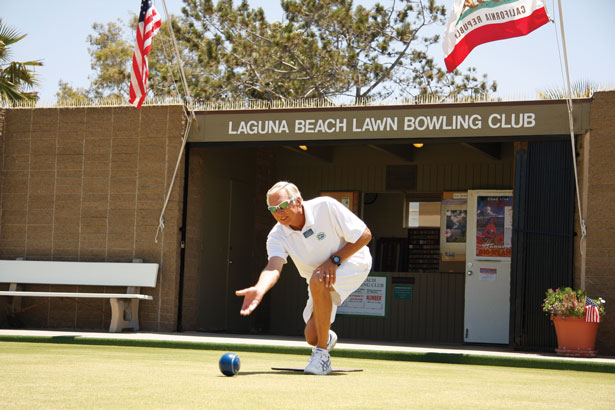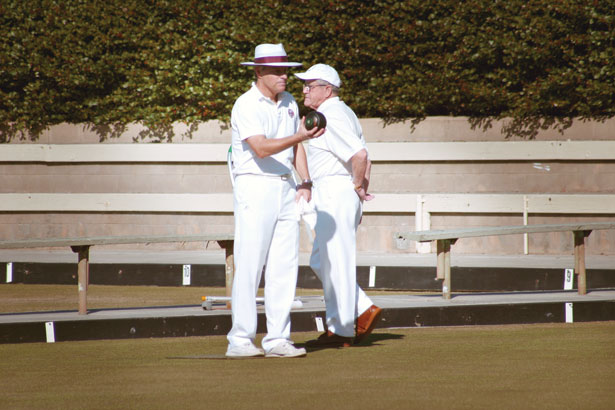The ancient sport of lawn bowling seeks new and younger players.–By Ashley Breeding
 Known also as “bowling on the green,” “bowls” and “bocce,” lawn bowling—from a distance—doesn’t appear a very thrilling sport. In fact, anyone strolling through Heisler Park past the Laguna Beach Lawn Bowling Club green is more likely to be captivated by the bluff-top view than the activity on the field itself. But give this game a shot, and you’re likely to get hooked.
Known also as “bowling on the green,” “bowls” and “bocce,” lawn bowling—from a distance—doesn’t appear a very thrilling sport. In fact, anyone strolling through Heisler Park past the Laguna Beach Lawn Bowling Club green is more likely to be captivated by the bluff-top view than the activity on the field itself. But give this game a shot, and you’re likely to get hooked.
Take Your Mark
Adrenaline junkies need not apply; this game is less about action and more about strategy. You can have the rules down after a session or two, but acquiring a strong skill set isn’t so simple.
Played in pairs, triples or quadruples, the goal of the game is to roll more of your team’s bowls closer to the jack—a small white ball, or marker—than the opposing team at each “end” (an inning, of sorts) played. Each person is allowed four rolls in a two-person game (three rolls in triples, two in quadruples), and the team who rolls the bowl closest to the jack scores a point for that bowl, and any additional bowl that lies within closer proximity to the jack than the opponent’s closest bowl. Sounds easy, right?
Not quite. Upon picking up a bowl, you’ll notice that something is off about this seemingly normal “ball.” The bowl has a bias, with a built-in weight to one side. Therein lies the challenge: You’ll want the bowl to curve left or right—the opposite side of the jack at which you aim, and how deep it will turn depends on the speed at which you roll it, the precision of your aim (called “the grass”) and the condition of the green (it’s not as smooth as it appears).
“The first rule is to always roll the bowl on its smooth sides—those without any emblems or markings,” advises Joe Regan, an OC native and professional lawn bowler on the U.S. team. “Second, you want to release the bowl smoothly, aiming at a distinct point that you hope will bring the bowl to rest at its best target position.”
And whatever you do, don’t get caught releasing the bowl with the bias to the wrong side, sending your bowl into a neighboring lane. Spectators have a big ole bell for such occasions and revel in the opportunity to ridicule you for such a folly.
After establishing your style and form, the fun—and competitiveness—begins. Once a few rolls have been made close to the jack, opponents can aim to knock each other out of the way. Just be sure not to knock your own best roll farther away from your mark—it could cost you the winning point.
Games typically go about 14 ends, or to a certain number of points—between 12 and 18—depending on the number of bowlers and level of competition. Expect it to be an all-day event—since socializing with friends is a large component of the sport, you won’t mind taking the entire day to play.
While the Laguna Beach Lawn Bowling Club has been around since the early 1930s, the sport itself—as it is played today—originated in England in 1299, where it remains wildly popular, says Curt Bartsch, an avid lawn bowler and past president of the club.
Historians suggest the modern game of lawn bowling was born from the Roman Empire, when soldiers would toss stones as close as they could to a target stone. The game that came to be bocce in Italy later made its way to France, where “boules,” as it was called, introduced balls instead of stones that were rolled rather than tossed. This version of the game was also played in Scotland, where it’s said to have been a favorite pastime among legendary characters like Robert Burns and Sir Walter Scott.
During the 14th century, Henry VII—an avid lawn bowler himself—banned the sport among lower classes because he said it was monopolizing the time men should have been spending practicing archery, an imperative military skill. The king even levied a £100 fee on private bowling greens to ensure the game remained a pastime of the wealthy. But the sport persevered and eventually made its way to America via English colonists, where it also faced challenges. It wasn’t revived until the 19th century, when Scottish immigrants started lawn bowl clubs. The sport grew more popular from coast to coast, and in 1915, the American Lawn Bowls Association (now called the United States Lawn Bowls Association) came about.
The Laguna Beach club was established in 1931, shortly after H.G. Heisler donated the parkland to the city, which dedicated the land to a bowling green at the request of Harlan S. Kittle and his fellow lawn bowling committee. The grounds remain under the city’s ownership, while the clubhouse operates on funds from membership fees. The club also received a large donation from Marcellus L. Joslyn, who created trusts for many of the Southwest Division clubs before his death in 1963.
Grooming the “Groms”
In the past, lawn bowling has mainly been enjoyed by an older demographic, at least locally.
In recent years, membership at the Laguna Beach Lawn Bowling Club has grown to about 200, attracting players of all ages. “We’re now grooming people in their 30s and 40s who are becoming as addicted to [the sport] as the older folks,” Curt says. He attributes the club’s success in drawing new members to a few factors: its proximity to the beach, scenic views and warm, outdoor setting, where it can be enjoyed year-round. “Young adults walk by and are curious,” he adds. “Once we get the young people to come in and try it, they leave energized and spread the word among their friends.”
Perhaps the shift in demographic is also due to efforts the club has made to expose lawn bowling to the community. Last year, the club invited locals to try their hand at bowls, enjoy a barbecue and mingle with neighbors. It also offered a discounted membership for those who signed up same-day.
“From time to time we also host corporate team-building events, where companies close their office for the afternoon and look for fun, different activities to do offsite,” Curt explains. “Just recently we hosted footwear brand Olakai. We supplied all of the equipment and volunteer coaches. The company employees—many in their 30s—all wore special T-shirts made for the occasion and had a great time.”
The Big Leagues
Most locals aren’t even aware that professional lawn bowling exists, but higher recognition is bound to come this year, when the Laguna Beach Lawn Bowling Club hosts, for the first time on Sept. 14, the U.S. Open Grand Finals—a culmination of a week-long professional bowls event. Hosted by the Southwest Division of the United States Lawn Bowling Association, the event features the best lawn bowlers from around the globe, including Australia, England, Ireland, Scotland, China, Hong Kong, South Africa and the U.S, says Mert Isaacman, who organized this year’s event.
They’ll get the bowl rolling with an opening celebration, followed by men’s and women’s competitions in singles, pairs and fours, held at various club greens in Southern California throughout the week (for locations and events, visit usopenlawnbowls.com). “I guess it’s sort of like tennis, which people can relate to,” Curt says.
Lawn bowling may not have gained widespread interest in these parts (yet), but in other countries it still serves as a popular pastime for spectatorship—earning the kind of attention that Major League Baseball or tennis does here, Joe explains.
“Something that still trips me out is when I was away for a [professional competition] and was watching ‘Bowls Australia’ on local television (it’s a common sport to be aired) on a Saturday night, and the next day I was competing against one of the bowlers I saw on TV the night before,” he recalls. He says he also receives the kind of attention from fans abroad that professional athletes do here in the states.
Most tournament qualified bowlers (pros) play for money, which, unfortunately, isn’t the case for American players. “Here, we’re not paid as much as they are in say, Australia,” Joe explains. “Expenses are not covered here; we’re lucky to win some [prize] money back for our travel expenses.” This is a common frustration of the sport for Americans, Joe says, who hope to one day draw in a higher financial reward.
“Right now, we mainly just [compete] for the notoriety.”
Some are even pushing to enter the sport into the Olympics, according to World Bowls, the top organization that brings bowlers together in competition from all over the world. As the game gains a more fast-paced, highly competitive edge that encourages media coverage, that goal may just be in sight. LBM
Retro Whites Nights
The Laguna Beach Lawn Bowling Club occasionally invites friends of members to try their hand at lawn bowling, sip cocktails and mingle, under one condition: “They must dress in preppy vintage whites and bring the [sauce],” says Jason Adams, an avid bowler and club member who’s taken part in a Retro White Party or two. “The sunset event usually draws in a group of 30-somethings and is a great time.” To score an invitation, befriend a club member today. (Or, to become a club member, visit lagunabeachlawnbowling.com)







